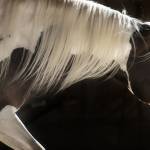Hypersalivation in Horses: Look at Feedstuffs

In hopes of better understanding feed-related causes of hypersalivation in horses, German researchers put out an alert to horse owners in Middle Europe, encouraging owners of horses displaying excessive salivation to contact them, collect samples of their horses’ feeds, including forages and pastures, and have the horse examined by their veterinarian.* They were looking for toxin-induced causes of the excess salivation, such as mycotoxins, which are poisonous substances produced by mold or fungi.
According to the researchers, mycotoxins produced by the fungus Slafractonia leguminicola (formerly named Rhizoctonia leguminicola), specifically slaframine and swainsonine, are known to cause hypersalivation in horses. Hypersalivation is sometimes called slobbers or slobber syndrome. Ergot alkaloids may also cause hypersalivation in animals, and these are produced by an endophyte (fungal parasite) that infects tall fescue and ryegrass.
Eleven outbreaks of hypersalivation were reported to the researchers during the study period.
“The research team noted that this was a ‘surprisingly high’ prevalence of hypersalivation all in one geographic area,” noted Kathleen Crandell, Ph.D., a nutritionist for Kentucky Equine Research. “Not all horses on each property were affected where an outbreak was reported.”
The saliva of affected horses was most often watery but sometimes foamy. In some cases, lesions of the tongue or gums, such as ulcers, were also observed.
“Other causes of hypersalivation were ruled out by the horses’ veterinarians, including chemical exposure, neurologic disorders, dysphagia or choke, and infectious diseases, leaving feed-related causes as the culprit,” Crandell said.
Samples of hay, pasture, grains, and concentrates were promptly presented to the researchers for evaluation. Samples were first visually inspected, and abnormal discoloration were noted, such as black, brown, and red patches. In all samples with legumes (clover and alfalfa), discolored spots together with holes in the leaves were specifically recorded. On ryegrass, black grain-like particles were found consistent with “ergot sclerotia.”
Select samples of forages were further evaluated for swainsonine, slaframine, and ergot alkaloid levels. Ergot alkaloids were identified in feedstuffs submitted from two of the three outbreaks where foamy hypersalivation was noted. Swainsonine was only identified in two of the 13 analyzed samples.
“Although a definitive mycotoxin was not identified in most outbreaks included in the study, the researchers reported that the underlying cause of the hypersalivation was related to forage. They further reported that the type of toxin–ergot alkaloid or slaframine/swainsonine, dose and duration of exposure–could account for the difference in time to resolution,” Crandell said.
Importantly, no other clinical signs were observed in affected horses with hypersalivation, such as weight loss, reduced feed intake, loss of condition, or fever. Horses recovered fully over the course of days to weeks following a change in diet.
“In sum the researchers stated that mycotoxin contamination of feedstuffs should be considered as a potential cause of hypersalivation in horses,” said Crandell.
If mycotoxin contamination is suspected, feedstuffs, particularly hay, should be immediately changed and access to pasture limited or eliminated. Rather than relying solely on the appearance of the feedstuffs, samples should be analyzed grossly for evidence of fungal contamination and evaluation of mycotoxins by an expert.
When changing feeds abruptly, be sure to consider the health of the intestinal microbiota—the population of bacteria and other microorganisms that contribute to the overall health of your horse. The microbiome plays key roles in producing energy, supporting the immune system, and in the gut-brain axis.
“The hindgut buffer EquiShure may be beneficial when transitioning between different feedstuffs by stabilizing the pH of the hindgut, supporting a consistent environment for the beneficial microbes,” advised Crandell.
*Böswald, L.F., C. Gottschalk, F. Kaltner, J. Merk, K. Schwaiger, and E. Kienzle. 2024. Feed-induced hypersalivation in horses from Austria, Germany and Switzerland. Equine Veterinary Journal:14433.








